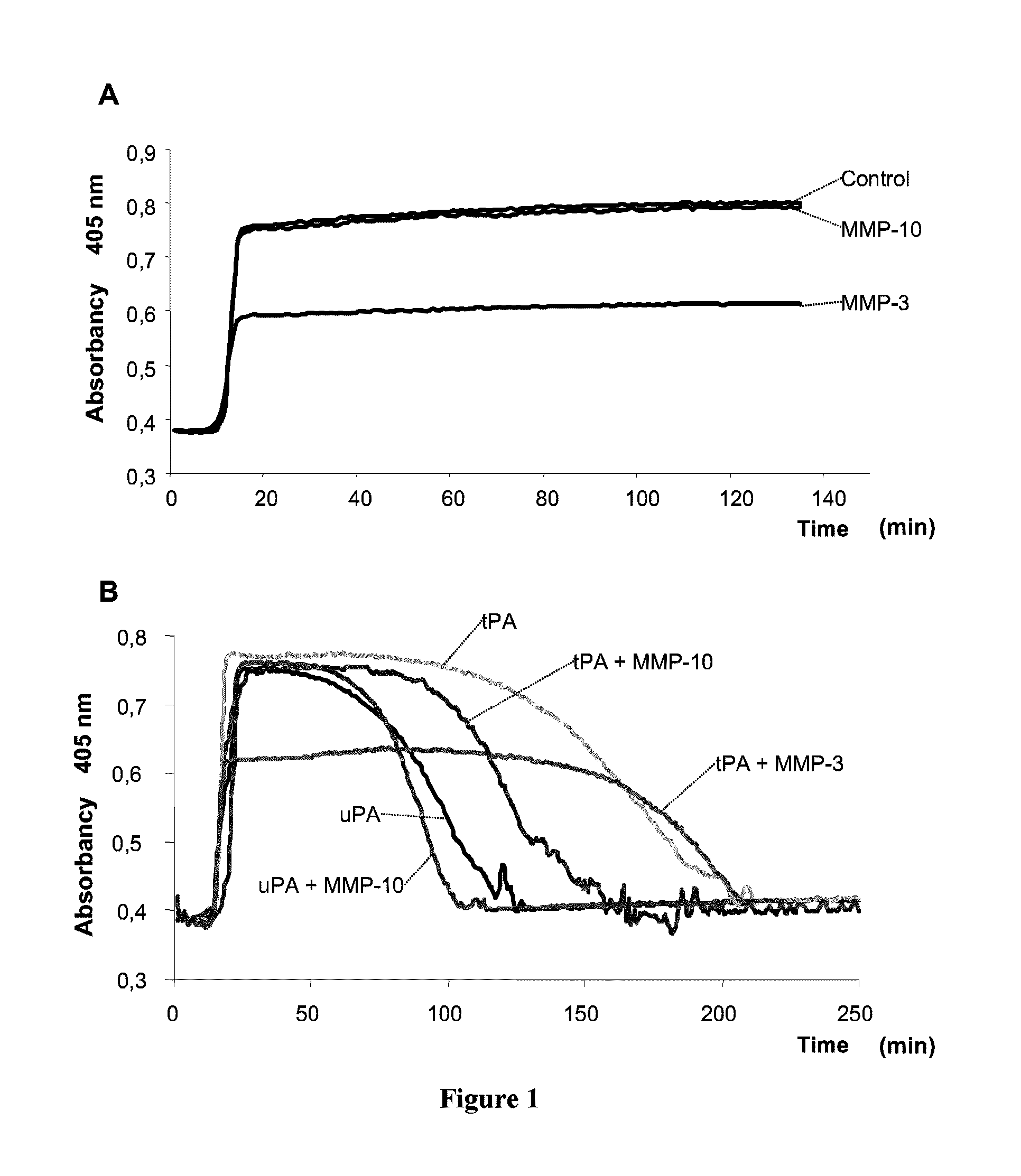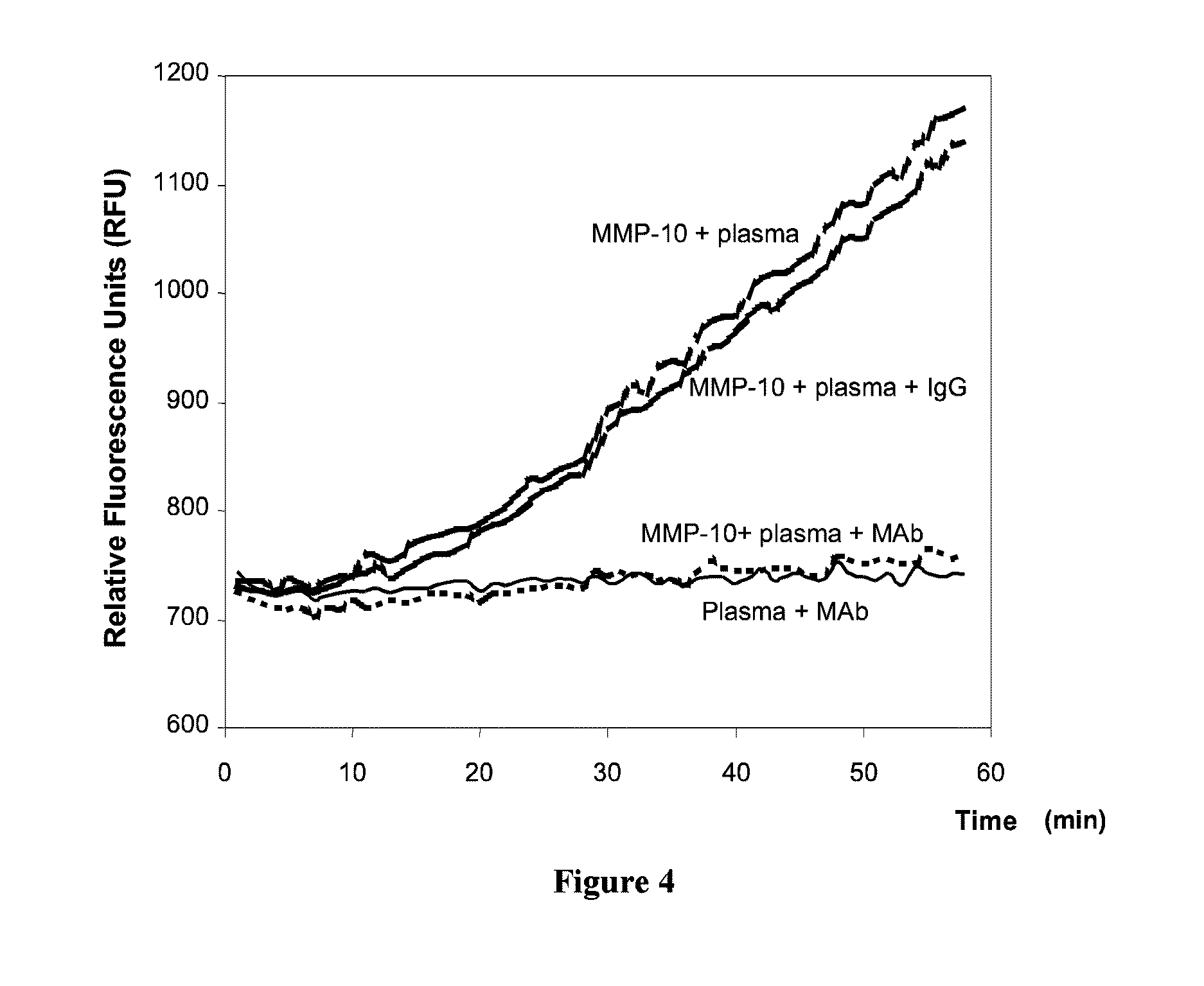Use of matrix metalloproteinase-10 (MMP-10) for thrombolytic treatments
a matrix metalloproteinase and thrombolytic technology, applied in the field of pharmaceutical compositions, can solve the problems of high hemorrhagic percentage, failure of fibrinolytic treatment, side effects, etc., and achieve the effect of reducing the maximum absorbency/turbidity of the clot, and altering the clot-forming ra
- Summary
- Abstract
- Description
- Claims
- Application Information
AI Technical Summary
Problems solved by technology
Method used
Image
Examples
example 1
Effect of MMP-10 and MMP-3 on Clot Formation and Lysis
[0069]As previously mentioned hereinabove, by means of the procedure described by von darn Borne et al., an evaluation was conducted of the effect of MMP-10 and MMP-3 on the haemostatic system. In this method, the changes in turbidity / absorbency during the formation and lysis of clots are assessed as an indicator of the length of both of these processes. The turbidity is measured by reading the absorbance at 405 nm during the clot formation and lysis phases using a photometric reader, which, in our case, was an ELISA reader (Fluostar Optima, BMG Labtech). The increase in turbidity / absorbance indicates the formation of the fibrin clot, whilst the lessening of this parameter indicates the lysis of the clot.
[0070]For the formation of the clot, 75 μl citrated plasma, 75 μl HEPES buffer (25 mM HEPES, 137 mM NaCl, 3.5 mM KCl, 6 mM CaCl2, 1.2 mM Mg Cl2, and 0.1% BSA, pH=7.5) and 10 μl CaCl2 150 mM were mixed in a micro-plate well. The p...
example 2
Effect of MMP-10 on Fibrin Degradation
[0081]According to the aforementioned Edward procedures, a study was made of the effect on fibrin lysis by measuring the halo or lysis area which is caused on a polymerized fibrin plate.
[0082]The fibrin plates are prepared from a 6 mg / ml human fibrinogen solution (Sigma, F3879, Saint Louis, Mo., USA) in veronal buffer (BioWhittaker, 12-624E, Cambrex, Md., USA) at 37° C., which is filtered and to which an equal volume of CaCl2 (50 mM) is added. This solution (6 ml) is mixed with 1 international unit (NIH units) thrombin (Enzyme Research Lab; HT1200a, Swansea, UK) and is left to polymerize for 6 h.
[0083]To assess the fibrinolytic capacity, tPA (1 U / ml), MMP-10 (200 nM) or a combination of the two were added to different fibrin plates.
[0084]As is shown in FIG. 2, the MMP-10 alone did not cause lysis on the polymerized fibrin, whilst the tPA caused a marked halo. However, the combination of tPA and MMP-10 significantly increased the polymerized fibr...
example 3
Effect of Coadministration of MMP-10 and a Thrombolytic Agent (tPA or uPA) on Clot Lysis
[0085]Given the effect of the MMP-10 on the tPA-included lysis, the question was posed of ascertaining whether it is possible to reduce the dose of tPA (which entails hemorrhage and neurological toxicity-related problems) and use MMP-10 as a coadjuvant for achieving the same thrombolytic effect.
[0086]In the turbidimetry test conducted following the procedure described in Example 1 hereinabove, we found that the presence of MMP-10 (200 nM) in combination with the tPA makes it possible to reduce the dose of tPA by 33% (from 30 to 20 U / ml), achieving the same clot lysis time (FIG. 3, table 1).
[0087]This result indicates that in a subject who needs thrombolytic therapy, MMP-10 provides the way to increase the fibrinolysis and clot lysis by simultaneously lowering the dose of tPA and therefore, minimizing the hemorrhagic and toxicity-related problems caused by this drug.
PUM
| Property | Measurement | Unit |
|---|---|---|
| lysis time | aaaaa | aaaaa |
| lysis time | aaaaa | aaaaa |
| pH | aaaaa | aaaaa |
Abstract
Description
Claims
Application Information
 Login to View More
Login to View More - R&D
- Intellectual Property
- Life Sciences
- Materials
- Tech Scout
- Unparalleled Data Quality
- Higher Quality Content
- 60% Fewer Hallucinations
Browse by: Latest US Patents, China's latest patents, Technical Efficacy Thesaurus, Application Domain, Technology Topic, Popular Technical Reports.
© 2025 PatSnap. All rights reserved.Legal|Privacy policy|Modern Slavery Act Transparency Statement|Sitemap|About US| Contact US: help@patsnap.com



